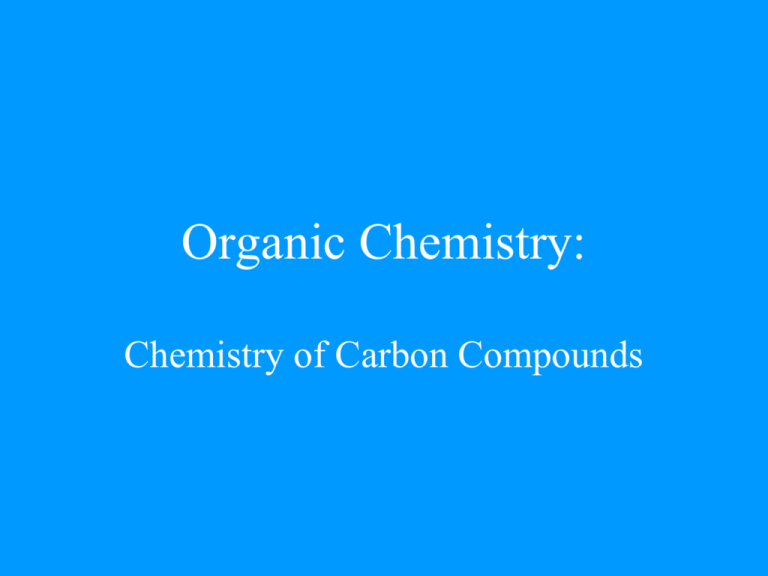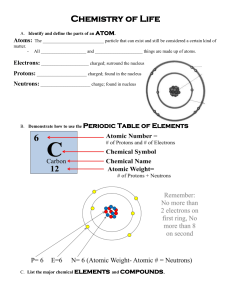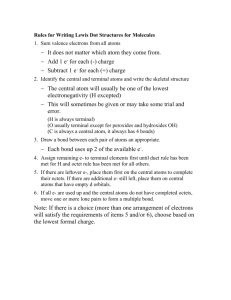Homologous Series
advertisement

Organic Chemistry: Chemistry of Carbon Compounds Why so many C compounds? • Carbon atoms can bond with other carbon atoms in chains, rings, and networks. • Bonds are covalent. Lewis Diagram of C • •C• • Carbon has 4 unpaired electrons. It can form 4 covalent bonds. Bonding Capacity of H, O, etc. • H can form only 1 bond. • O and S like to form 2 bonds. • The halogens (F, Cl, Br, I) form only 1 bond. • N and P form 3 bonds. Properties of Covalent Substances • • • • • • (also called molecular substances) Low melting & boiling points Poor conductors of heat & electricity May be soft or brittle Generally nonpolar Tend to dissolve in nonpolar solvents React more slowly than ionic compounds Chemical Formulas • show kind & number of atoms. CH4, CH3OH, CH3Cl, CH2Cl2 Structural Formulas • Show kind & number of atoms. • Also show bonding patterns and approximate shapes of molecules. • 2-D rep of 3-D object so structural formulas aren’t totally realistic. H H–C–H H Structural Formulas • – A single line represents one pair of electrons (a single bond). • = A double line represents two pairs of electrons (a double bond). • A triple line represents three pairs of electrons (a triple bond). Shape • The 4 unpaired electrons around the C atom are located at the corners of a tetrahedron. • 109.5 apart. Vocabulary Interlude • Saturated: organic compounds containing only single bonds. • Unsaturated: organic compounds containing one or more double or triple bonds. Vocabulary • Hydrocarbons: organic compounds containing only C and H. • Homologous Series: a group of compounds with related structures and properties. Each member of the series differs from the one before it by the same additional unit. Condensed Structural Formula • Shows kind & number of atoms • Shows some structural information, but not all the details. H H H H–C–C–C–H H H H Becomes CH3CH2CH3 Alkanes • Homologous series of saturated hydrocarbons. • Release energy when burned. CH4 H H–C–H H C2H6 H H H–C–C–H H H • Or CH3CH3 Alkanes or CnH2n+2 • C3H8 H H H H–C–C–C–H H H H CH3CH2CH3 th 4 straight-chain alkane C4H10 H H H H H–C–C–C–C–H H H H H Or CH3CH2CH2CH3 Alkanes: base unit CH4 CH3CH3 or C2H6 CH3CH2CH3 or C3H8 CH3CH2CH2CH3 or C4H10 CH3CH2CH2CH2CH3 or C5H12 Difference between each is CH2 Naming straight-chain Alkanes • All alkanes have the suffix –ane. • The prefix depends on the number of C’s. Prefix Meth Eth Prop But Pent Hex Hept Oct Non Dec # of C atoms 1 2 3 4 5 6 7 8 9 10 Formula Name CH4 Methane C2H6 Ethane C3H8 Propane C4H10 Butane C5H12 Pentane Properties of Alkanes • Change systematically with number of C’s • As the number of C’s increases, the boiling point increases. Branched-chain alkanes • Beginning with butane, C4H10, there is more than 1 way to arrange the atoms. H H–C–H H H H–C–C–C–H H H H Isomers • Compounds with the same molecular formula but different structural arrangement, and therefore, different chemical properties. • The more C atoms there are in the formula, the more isomers there will be. More possible ways to arrange them. Isomers • Different structures, different properties. • Isomers have different chemical and physical properties. Naming branched-chain alkanes • Find the longest continuous chain or backbone of C atoms. (Bends don’t count!) • The base name is derived from the number of C’s in the longest chain. • Branches are named in the prefix. Branches are also named by the number of C atoms. The “branch” part of the name ends in “yl.” • The location of the branch is shown by assigning numbers to the C’s in the backbone. Number from the end that gives the lowest number for the branch. • There may be more than 1 of the same type of branch. Use di, tri, etc. H H–C–H H H H–C–C–C–H H H H Longest continuous chain has 3 carbon atoms – propane. Branch has 1 carbon – methyl. Branch has to be at C-2. (Only give the number if necessary.) Methyl propane C4H10 CH3CH(CH3)CH3 H H–C–H H–C–H HH H H–C–C–C–C–H H H H H–C–H H Longest continuous chain has 6 carbon atoms. It’s a hexane. Branch is 1 carbon long – methyl. Branch is located at C-2. 2-methyl hexane C7H16 CH3CH(CH3)CH2CH2CH2CH3 H H–C–H H H H H– C–C–C–C–H H H H–C–H H–C–H H H Longest continuous chain has 6 carbon atoms: hexane Branch is 1 carbon long: methyl Branch is located at C-3 3-methyl hexane C7H16 CH3CH2CH2CH(CH3)CH2CH3 CH3(CH2)2CH(CH3)CH2CH3 Alkenes • Another homologous series of hydrocarbons. • Each member contains one double covalent bond between C atoms. So alkenes are unsaturated. • General formula = CnH2n Naming Alkenes • Names are derived from the name of the alkane chain with the same number of C atoms. Replace the –ane ending of the alkane name with –ene. 1st member is C2H4, ethene. H H C=C H H Naming Alkenes • Location of double bond is specified by numbering C atoms in backbone. Give bond the lowest possible number. 1-butene H HH C=C–C–C–H H H H H 2-butene H H HH H–C–C=C–C–H H H C4H8 C4H8 CH2CHCH2CH3 CH3CHCHCH3 Naming Branched-Chain Alkenes • Parent chain = longest chain that contains the double bond. • Also, position of double bond, not branches, determines numbering of backbone. • Give 1st C in bond lowest possible #. Alkynes • Homologous series of unsaturated hydrocarbons that contain one triple bond. • Each member contains one triple carboncarbon bond. – • Alkynes are unsaturated. General formula = CnH2n-2 Naming Alkynes • Use the corresponding name from the alkane series and change the –ane to –yne. • If necessary, number the carbon atom at which the triple bond occurs. H–CC–H C2H2 ethyne CHCH H H–CC–C–H H C3H4 propyne CHCCH3 HH H–CC–C–C–H HH C4H6 1-butyne CHCCH2CH3 H H H–C–CC–C–H H H C4H6 2-butyne CH3CCCH3 Organic Halide • One or more of the hydrogen atoms in an alkane is replaced with a halogen (F, Cl, Br, or I). • Not hydrocarbons! Often called halocarbons. • Use prefixes to specify substituent: fluoro, chloro, bromo, iodo • If more than one, use di, tri, etc. to specify # of substituents. • If necessary, give locations by numbering C-atoms in backbone. Naming Halides CH3Cl H H–C–Cl H chloromethane CH3CHFCH3 H H H H–C–C–C–H H F H 2-fluoropropane C3H7F Naming Halides CH3CCl2CHClCH3 H Cl H H H–C–C–C–C–H H Cl Cl H 2,2,3-trichlorobutane C4H7Cl3







